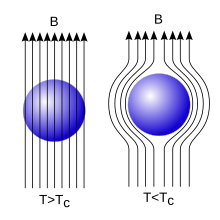
| Condensed matter physics |
|---|
 |
Superdiamagnetism (or perfect diamagnetism) is a phenomenon occurring in certain materials at low temperatures, characterised by the complete absence of magnetic permeability (i.e. a volume magnetic susceptibility = −1) and the exclusion of the interior magnetic field.
Superdiamagnetism established that the superconductivity of a material was a stage of phase transition. Superconducting magnetic levitation is due to superdiamagnetism, which repels a permanent magnet which approaches the superconductor, and flux pinning, which prevents the magnet floating away.
Superdiamagnetism is a feature of superconductivity. It was identified in 1933, by Walther Meissner and Robert Ochsenfeld, but it is considered distinct from the Meissner effect which occurs when the superconductivity first forms, and involves the exclusion of magnetic fields that already penetrate the object.

© MMXXIII Rich X Search. We shall prevail. All rights reserved. Rich X Search

